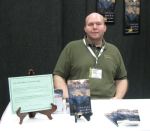Thanks largely to enhanced streaming capabilities, the past few years have witnesses an increase in the amount of television binge watching. Not only is this method an addicting way to watch your favorite show, some shows have actually restructured their writing to meet this trend. HBO’s Programming President, Michael Lombardo, defended the second season of True Detective by saying viewers needed to, “watch the entirety of it,” before passing judgment, despite the episodes being released one at a time. Netflix and other distributors eschew the week-to-week delivery of content and release entire seasons of their shows in one go with the expectation that loyal fans will be discussing the final episode by the end of the day.
But binge consumption of genre related entertainment is nothing new. Readers have done the same for decades. Maybe not in one butt-numbing stretch, but in eagerly devouring everything an author can produce, and often as fast as the author can produce it. And the funny thing is, this trend occurs whether the author is a favorite or new to the reader. Readers will find out what the author has written before and grab it, even buying blocks of books on Amazon–hey, they’re discounted that way–before cracking open the first volume.

In fact, it is sometimes difficult for new authors to sell their first book solely because readers don’t want to invest in something they can’t read more of if they happen to get hooked. I have witnessed this first-hand at conventions. At GenCon’s Author Alley in 2011, I was hard-pressed to get readers to take a gamble on a single, slim-for-fantasy novel, The Roads to Baldairn Motte, but those authors pitching multiple volumes–who were just as unheard of as I was–continuously piqued readers’ interests not by their series tagline but by the sheer amount of content they were offering! Seven massive tomes always looks more enticing on a table than a single book.
 Authors like Brian McClellan have adopted a clever strategy to grab the attention of modern readers and keep them sated. He released novellas surrounding the narrative of his main novels. These are short spin-offs cast from different character viewpoints or set at different points in time. (See Battleship Galactica for an example of how television has done the same thing while viewers waited for the next season.) The novellas give existing readers additional content delivered at a pace months (if not years, Mr. Martin) faster than waiting on a longer novel, and they also present new readers with an Author page filled with content. Even better, with ebook novellas offered as cheap as they are, it’s a financially viable solution for both parties. (McClellan’s novellas are roughly one-third the cost of his novels.)
Authors like Brian McClellan have adopted a clever strategy to grab the attention of modern readers and keep them sated. He released novellas surrounding the narrative of his main novels. These are short spin-offs cast from different character viewpoints or set at different points in time. (See Battleship Galactica for an example of how television has done the same thing while viewers waited for the next season.) The novellas give existing readers additional content delivered at a pace months (if not years, Mr. Martin) faster than waiting on a longer novel, and they also present new readers with an Author page filled with content. Even better, with ebook novellas offered as cheap as they are, it’s a financially viable solution for both parties. (McClellan’s novellas are roughly one-third the cost of his novels.)
Which brings me to Souldrifter, the second volume of Garrett Calcaterra’s Dreamwielder Chronicles. I’m excited for this book not just because it promises great adventure and an expansion to the vast, rich world first established by Dreamwielder, but because I know new readers will take a chance on the books marketed as a series where they might have passed on each individually. The door is open for a whole new readership to find Makarria, who, as Wendy Wagner, author of the Pathfinder Tales novel, Skinwalkers, points out, “…is a teenage heroine who does more than just kick butt: she’s smart, powerful, and surprisingly believable for a fourteen-year-old queen.”

Bruce McAllister, author of The Village Sang to the Sea, adds, “Souldrifter meets the promise of its predecessor with royal trumpets. Fine writing, magic, epic intrigue, a great cast, and a central character (Makarria) who mesmerizes—what more does a reader need to be happy?”
As much as they can consume, of course!


 It’s long been argued that all fictional characters contain some facet of the author. To what extent remains a debate, but what about setting? After all, in fantasy and science fiction, the where can be more important than the who or the what. Who is Robb Stark without the cold north of Westeros? Or Katniss Everdeen without Panem and the Hunger Games arena? But does that mean that without living through a Chicago winter,
It’s long been argued that all fictional characters contain some facet of the author. To what extent remains a debate, but what about setting? After all, in fantasy and science fiction, the where can be more important than the who or the what. Who is Robb Stark without the cold north of Westeros? Or Katniss Everdeen without Panem and the Hunger Games arena? But does that mean that without living through a Chicago winter, 